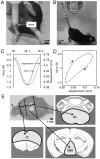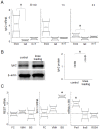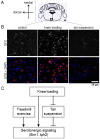Physical weight loading induces expression of tryptophan hydroxylase 2 in the brain stem
- PMID: 24416346
- PMCID: PMC3885668
- DOI: 10.1371/journal.pone.0085095
Physical weight loading induces expression of tryptophan hydroxylase 2 in the brain stem
Abstract
Sustaining brain serotonin is essential in mental health. Physical activities can attenuate mental problems by enhancing serotonin signaling. However, such activity is not always possible in disabled individuals or patients with dementia. Knee loading, a form of physical activity, has been found to mimic effects of voluntary exercise. Focusing on serotonergic signaling, we addressed a question: Does local mechanical loading to the skeleton elevate expression of tryptophan hydroxylase 2 (tph2) that is a rate-limiting enzyme for brain serotonin? A 5 min knee loading was applied to mice using 1 N force at 5 Hz for 1,500 cycles. A 5-min treadmill running was used as an exercise (positive) control, and a 90-min tail suspension was used as a stress (negative) control. Expression of tph2 was determined 30 min - 2 h in three brain regions --frontal cortex (FC), ventromedial hypothalamus (VMH), and brain stem (BS). We demonstrated for the first time that knee loading and treadmill exercise upregulated the mRNA level of tph2 in the BS, while tail suspension downregulated it. The protein level of tph2 in the BS was also upregulated by knee loading and downregulated by tail suspension. Furthermore, the downregulation of tph2 mRNA by tail suspension can be partially suppressed by pre-application of knee loading. The expression of tph2 in the FC and VMH was not significantly altered with knee loading. In this study we provided evidence that peripheral mechanical loading can activate central tph2 expression, suggesting that physical cues may mediate tph2-cathalyzed serotonergic signaling in the brain.
Conflict of interest statement
Figures




Similar articles
-
Analysis of tryptophan hydroxylase I and II mRNA expression in the human brain: a post-mortem study.J Psychiatr Res. 2007 Jan-Feb;41(1-2):168-73. doi: 10.1016/j.jpsychires.2005.05.004. Epub 2005 Jul 14. J Psychiatr Res. 2007. PMID: 16023677
-
[Alterations in the Level of mRNA of TPH1, TPH2 Genes, Tryptophan Hydroxylase Activity and Serotonin Metabolism in Mouse Brain Five Days after Lipopolysaccharide Administration].Mol Biol (Mosk). 2023 Mar-Apr;57(2):299-306. Mol Biol (Mosk). 2023. PMID: 37000657 Russian.
-
Simultaneous analysis of serotonin transporter, tryptophan hydroxylase 1 and 2 gene expression in the ventral prefrontal cortex of suicide victims.Am J Med Genet B Neuropsychiatr Genet. 2010 Jun 5;153B(4):909-18. doi: 10.1002/ajmg.b.31059. Am J Med Genet B Neuropsychiatr Genet. 2010. PMID: 20052688
-
Serotonergic neurotransmission manipulation for the understanding of brain development and function: Learning from Tph2 genetic models.Biochimie. 2019 Jun;161:3-14. doi: 10.1016/j.biochi.2018.11.016. Epub 2018 Dec 1. Biochimie. 2019. PMID: 30513372 Review.
-
Advances in tryptophan hydroxylase-2 gene expression regulation: new insights into serotonin-stress interaction and clinical implications.Am J Med Genet B Neuropsychiatr Genet. 2012 Mar;159B(2):152-71. doi: 10.1002/ajmg.b.32023. Am J Med Genet B Neuropsychiatr Genet. 2012. PMID: 22241550 Free PMC article. Review.
Cited by
-
Mechanical stimulations can inhibit local and remote tumor progression by downregulating WISP1.FASEB J. 2020 Sep;34(9):12847-12859. doi: 10.1096/fj.202000713RR. Epub 2020 Aug 3. FASEB J. 2020. PMID: 32744779 Free PMC article.
-
Unraveling the Molecular Determinants of Manual Therapy: An Approach to Integrative Therapeutics for the Treatment of Fibromyalgia and Chronic Fatigue Syndrome/Myalgic Encephalomyelitis.Int J Mol Sci. 2018 Sep 9;19(9):2673. doi: 10.3390/ijms19092673. Int J Mol Sci. 2018. PMID: 30205597 Free PMC article. Review.
-
Three-Week Treadmill Exercise Enhances Persistent Inward Currents, Facilitates Dendritic Plasticity, and Upregulates the Excitability of Dorsal Raphe Serotonin Neurons in ePet-EYFP Mice.Front Cell Neurosci. 2020 Oct 16;14:575626. doi: 10.3389/fncel.2020.575626. eCollection 2020. Front Cell Neurosci. 2020. PMID: 33177992 Free PMC article.
-
Mechanical tibial loading remotely suppresses brain tumors by dopamine-mediated downregulation of CCN4.Bone Res. 2021 May 24;9(1):26. doi: 10.1038/s41413-021-00144-2. Bone Res. 2021. PMID: 34031366 Free PMC article.
References
Publication types
MeSH terms
Substances
Grants and funding
LinkOut - more resources
Full Text Sources
Other Literature Sources

